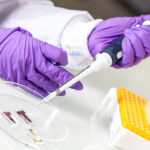Share this post:

Paris, France, January 22, 2018 – BioAxial, a key player in live cell super resolution microscopy, today announces that it has been granted a US patent covering ‘black fluorophore’, a pivotal component of ‘dark tracking’ technology. This patent consolidates BioAxial’s patent portfolio, which already comprises ten patent families. It also strengthens the company’s position as a technology leader in the field of commercial super-resolution imaging modules.
Dark tracking belongs to a new family of super resolution technologies in microscopy that is expected to achieve tracking or imaging at only a few nanometers or even a single nanometer, with low light levels.
BioAxial already designs and manufactures super-resolution imaging add-on modules based on its generic and patented CODIM (Conical Diffraction Microscopy) technology. Dark tracking will be included in the second generation of CODIM. By allowing the generation of compact and structured light distributions, the singular optic of CODIM technology, coupled with precise and fast control of a laser light beam, aims to provide access to single-molecule tracking with true nanoscopic molecular resolution, in low light. This will help assess dynamic molecular processes within their biological context.
BioAxial customers and partners will be readily able to use both standard CODIM and dark tracking technologies, using the same hardware, with the ability to switch from one to the other swiftly, as required. The company has integrated dark tracking into its current development roadmap and plans to commercialize new products with this technology.
“This patent presents a major boost for the life sciences industry. Dark tracking can become a key modality in fluorescence microscopy, which is already an essential tool in fundamental biology, medical research and drug discovery,” said Gabriel Sirat, CSO at BioAxial. “This is a clear recognition of our scientific achievements and gives us a strong IP standing in the field.”
“Today CODIM has been adopted by pharma and academic users in Europe, Japan and North America; dark tracking will greatly benefit our system’s second generation. It will improve considerably the performance and applicability of our CODIM modules,” said Georges Tabary, president and CEO at BioAxial. “Our intention is to widen its adoption by collaborating with all scientific and industrial players in the field.”
Black fluorophore was originally conceived as an integral part of CODIM technology; it was granted to BioAxial as a divisional patent, (US patent 9,846,030) with the priority date of October 15, 2010. This covers and describes not only the specific conical diffraction implementation used by BioAxial in CODIM, but also the generic method.
The global microscopy market is expected to reach €6.13 billion ($7.39 billion) by 2022, primarily driven by increased funding for R&D in microscopy, also technological advancements and the rise of regenerative medicine and nanotechnology. Additional favorable aspects include the widening application areas for microscopy as well as the integration with spectroscopy.
About BioAxial
BioAxial develops and sells CODIM, a new technology for super-resolved fluorescence microscopy for extended imaging of live cells currently with a resolution of 100nm. The modules manufactured by BioAxial can be adapted as an add-on to commercial microscopes. BioAxial was founded by Gabriel Sirat in 2010. It has its headquarters in Paris.
To download documents, you can right-click on the links above and chose « Save link as… »




